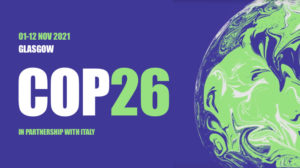The UK government has positioned itself as world leader in the fight against climate change and has committed to net zero by 2050. A key lever to achieving this is the decarbonisation of road transport and have already set dates for when the sale of conventional petrol and diesel cars and vans should end.
To facilitate the global transition to zero emission vehicles, the Zero Emission Vehicle Transition Council was set up. The council is made up of representatives from California, Canada, Denmark, European Commission, France, India, Italy, Japan, Mexico, Netherlands, Norway, Spain, South Korea and Sweden, the United Kingdom. They have agreed to collectively address some of the key challenges in the transition to zero emission vehicles to make this cheaper and easier for all.
Conference of the Parties

COP26 will be hosted by the UK in partnership with Italy and take place in Glasgow from 1 – 12 November 2021. The conference will review progress of the Paris Agreement and discuss achievement of the target to limit global warming to 1.5°C.
Organisations wishing to participate in the conference will need to make a commitment to the Race to Zero campaign.
Race to Zero

There are a number of Race to Zero partners that collaborate with businesses and will then also provide access to official COP26 activities.
-
Set a science based target
- Commit – Complete the standard commitment letter or the Business Ambition for 1.5°C commitment letter
- Develop – Develop a target in line with the science based criteria. Refer to the SBTi How To Guide.
Companies of less than 500 employees are defined as SMEs and must submit their target through the dedicated route for SME’s and use the Target Setting Letter.Companies of over 500 employees must have full GHG emissions screening/inventory across scope 1, 2 and 3 emissions. Offsets and avoided emissions must not be included. Direct CO2 emissions from bioenergy must be reported separately. Optional scope 3 emissions must be reported separately from emissions in the minimum boundary of each scope 3 category.Sector specific guidanceOEMs – Scope 1 and 2, sufficient ambition if in line with the SDA Transport Tool for passenger light-duty vehicle (PLDV) manufacturers or absolute contraction approach.Scope 3 – targets covering use of sold products must meet the minimum level of ambition determined by the SDA Transport too covering well to wheel (WTW) emissions of sold vehicles and aligned to the well below 2°C pathway.The target must be developed, validated and published within 24 months of signing the commitment. - Submit – The target must be submitted for validation using the target submission form. The target validation service costs $4,950.
- Communicate – Once the target has been validated it will be published on the Science Based Targets website alongside other companies. Companies are encouraged to communicate through their own channels.
- Disclose – Disclose annual emissions through regular communications channels.
-
Coalition of business leaders working in partnership with the Race to Zero Campaign. Raises awareness across the business sector to accelerate action to address climate change, biodiversity loss and social injustice.
Businesses need to;
- Have an authentic commitment to making a climate transition backed at the top and throughout the organisation.
- Have a willingness to work towards a 2030 net zero target while being open to discuss the challenges involved.
- Have a willingness to share the journey and support Business declares advocacy efforts.
-
- Supports businesses to calculate, measure and track their carbon footprint.
- CBN Expert Dashboard – online tool to help you understand your current position, define your net zero strategy and help you develop the roadmap to get there.
-
- Supply Chain leaders commitment to reducing emission in line with the 1.5°C ambition.
- Supports SME’s through the SME Climate Hub
The Climate Pledge calls on companies and organisations to be net zero carbon across their business by 2040. Signatories of the Pledge commit to three principle areas of action:- Regular Reporting – Measure and report greenhouse gas emissions on a regular basis
- Carbon Elimination – Implement decarbonisation strategies in line with the Paris agreement through real business changes and innovations, including efficiency improvements, renewable energy, materials reductions, and other carbon elimination strategies
- Credible Offsets – Neutralise any remaining emissions with additional, quantifiable, real, permanent, and socially-beneficial offsets to achieve net zero annual carbon emissions by 2040.
-
Race to Breakthroughs sets out the specific, near-term tipping points for more than 20 sectors that make up the global economy, forming a master plan around which business, governments, and civil society can unite ahead of COP26.
The Race to Breakthroughs are derived from the Climate Action Pathways, a set of comprehensive roadmaps to achieve the Paris agreement in line with 1.5°C across all sectors. The aim is to reach breakthrough ambition (20% of key actors committed) for at least 10 sectors by COP26. 20% is seen as a tipping point for change and that after this the rate of growth will accelerate exponentially.
The key actors needed to drive a breakthrough are categorised into five groups;
- Supply side companies – e.g. manufacturers, producers, supply chain
- Demand side companies – e.g. retailers service providers, distributors
- Finance actors – e.g. investors, asset managers, asset owners, banks, public funds
- Policy makers – e.g. countries, cities, states, regions
- Civil society – customers, voters, universities, sports teams, local organisations








